| Web
and Book design,
Copyright, Kellscraft Studio 1999-2010 (Return to Web Text-ures) |
 (HOME)
|
| CHAPTER VII
WORK BASKETS As almost everyone who uses a work basket has a different ideal of what such a basket should be — in regard to size, capacity, shape and ornament — these descriptions are not to be taken as directions, but as suggestions which each basket maker can adapt or elaborate upon. In this way he can work out a basket suited to the taste and needs of the person by whom it is to be used.
Materials: -10 22-inch spokes of No. 4 rattan, 1 12-inch spoke of No. 4 rattan, 7 weavers of No. 2 rattan. A small open work basket which is pretty and serviceable; though simple, is made as follows: Two groups of spokes, one of five and the other of five and a half, are crossed in the centre in the usual way and bound around three times with a weaver of No. 2 rattan, which is woven in under-and-over weaving to a diameter of three and a half inches, when the spokes are wet and turned very gradually upward in a rounding flare. When three weavers and part of a fourth have been used, a fifth weaver is started beside the fourth in double weaving, which continues for five rows. The weavers are still left loose enough for the spokes to flare, and when the band of double weaving is finished, and an inch of under-and-over weaving has been made above it, the diameter of the top should be seven and five-eighths inches. It is then bound off and finished with the Rope Border described on page 39. The whole basket may be colored with a vegetable dye or stain, (see Chapter XII) or the band of double weaving may be woven with colored rattan, the rest of the basket being of rattan in its natural color. As the border ends inside and as there are also many little ends of weavers on the inside which would be troublesome in a work basket, a lining of silk in some harmonious color, with pockets and pincushion, will make it more practical.
Materials: BASKET-16 18-inch pieces of No. 2 rattan, 11 or 12 lengths of colored raffia, 1 1/2 weavers of No. 1 rattan. COVER AND HINGE- 16 16-inch pieces of No. 2 rattan, 7 or 8 lengths of colored raffia, 1/2 weaver of No. 1 rattan. A dainty little work basket just large enough to hold a small pair of scissors, needles, thread and a thimble will be a welcome gift to some globetrotting friend. Before beginning it a bunch of raffia should be dyed a pale color that will look well with the rattan, see Chapter XII. Such a fine rattan as No. 1 is not always obtainable, it is so seldom used, but in a tiny basket like this no heavier material will look as well. The sixteen eighteen-inch pieces of No. 2 rattan are separated into groups of four each. The first group is laid on a table in a vertical position. Across the centre of this group the second group is placed horizontally exactly at its centre, the third group crosses the other two diagonally with its upper end to the right of the upper part of the vertical group and its centre over the point where the other two cross. The fourth group is laid across the others diagonally, from the left of the upper part of the vertical group to the right of the lower part. A length of raffia is then doubled and started around the upper part of the vertical group, with its ends toward the right. It is woven in pairing to about seven-eighths of an inch from the centre, where the groups are divided, each making two groups containing two pieces of rattan. When a bottom two and a half inches in diameter, and slightly raised in the centre, has been woven the groups of spokes are thoroughly wet and turned up with a slight flare, using a No. 1 weaver in four rows of pairing. This is succeeded by seven-eighths of an inch of raffia in pairing, which flares for three quarters of an inch and is then drawn in gradually. In joining the ends of two weavers of raffia, two inches at least of the old and new weaver should be laid one on top of the other, twisted tightly together and woven as one strand; this will make a neater joining than crossing the ends back of a spoke. The band of four rows of pairing in No. 1 rattan which follows the raffia is also drawn in gradually, making a firm edge at the top of the basket. The groups of spokes are then wet and woven into a border which looks like a plait, and is made in this way. Each group of two spokes is brought back of the next group on the right, in front of the next and down inside the basket just behind the third group to the right of it. As usual in this kind of a closed border the first part of the border should be left loose and open until the last part has been woven in. Cover. — The same arrangement of groups of spokes is made in starting the cover as in the bottom of the basket, and it is woven in pairing with weavers of raffia, turning the spokes up from the very centre so as to make a slightly rounded cover. At seven-eighths of an inch from the centre the groups of four are divided into twos, and the pairing with raffia continues until the cover is three inches in diameter. Two rows of pairing in No. 1 rattan follow the raffia and they are succeeded by a single row of raffia and a border like the one on the basket. The hinge and fastening are made of raffia and rattan. Three strands of raffia sixteen inches long are braided and then cut into two pieces; one to form the hinge and the other the top loop of the fastening. The hinge is made by inserting one end of the braided raffia under a loop of the border to the left of a group of spokes on the basket. It is brought outside of the basket on the right of the group of spokes. Both ends are now on the outside of the basket and after placing the cover on the basket, to see where it will fit best, the ends are brought straight up, each over a lower loop in the border of the cover and one on either side of a group of spokes, to the inside of the cover. Here the ends of the braid are crossed and woven to right and left, under and over one or two spokes, to fasten them off. In the front of the cover an end of the other eight inch piece of braided raffia is pushed through to the inside, on the left of a group of spokes, and just above a lower loop of the border, The other end is brought inside to the right of the group of spokes; the ends are then drawn up until the loop on the outside is about an inch long, when they are crossed and woven to right and left under and over one or two spokes to fasten them securely. A piece of No. 1 rattan, about twelve inches long, is fastened to the basket just below the loop on the cover and between the lowest row in the band of rattan and the top of the woven raffia. It is brought up vertically and pushed inside the basket just below the border, making the foundation for a rattan loop which is formed in the same way as the small side handles described on page 55. Over this rattan loop the loop of braided raffia fits, and a piece of No. 5 rattan an inch long is slipped through the rattan loop and holds the cover close. That it may not be lost, a hole is bored in this piece of rattan and it is fastened to the basket by a bit of raffia; one end of which is tied through the hole in the rattan, the other secured around a spoke about an inch to the right of the fastening. The finishing touch of daintiness is to line this basket with silk, and fit into the hollow in the cover a round needle-book made of the same silk.
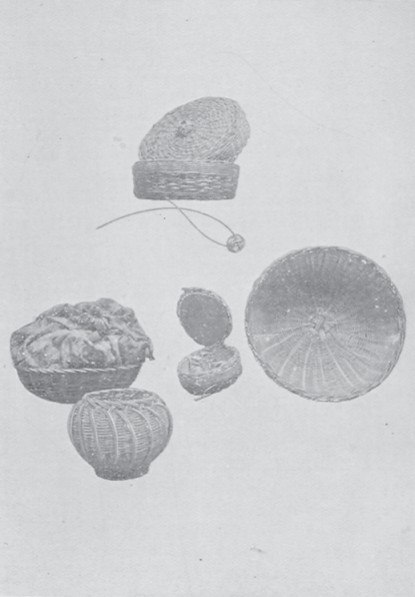
SOME WORK BASKETS The round knitting basket in the foreground is of rattan in the natural color, as is the large bowl-shaped basket on the right. In the centre is a small travelling work basket of pale green raffia, and on the left a green rattan basket with a soft silk top. Above is shown the Chinese button or knob which is used on the green rush covered basket
Materials: 16 34-inch pieces of No. 2 rattan, 32 17-inch pieces of No. 2 rattan, 11 or more weavers of No. 2 rattan, A knitting needle. The thirty-four-inch pieces of No. 2 rattan are arranged in groups of four and crossed in the centre as described on page 67. A single weaver is started by laying the end over the group to the left of the upper end of the vertical group, it is then brought under the vertical group, over the next, under the next and so on, until it comes around to the vertical group again. Here it goes under as before, over the next group and always under and over the same groups as at first. The weaver is brought around four times in this way, see Fig. 15. The groups are now separated into twos, and the weaver is brought over the left hand pair of the upper vertical group, under the pair on the right, and so on until it comes around again when it is brought under and over the same groups as in the row just completed, see Fig. 15. When the fourth row has been made in this way, another weaver is added, by inserting it between a group of spokes and the band of weaving which covers them, and the pairing of which the rest of the basket is to be woven is begun. The centre being woven in a design, is so ornamental that rather than cover it with a lining, which would be necessary if the usual method of joining weavers was followed, the end of each old weaver is run down between the weaving, on the left of a group of spokes, and the end of the new weaver is run down between the weaving to the right of the same group, see Fig. i6. When the bottom of the basket is five and a half inches in diameter, pieces of No. 2 rattan seventeen inches long are inserted, one on either side of every group of spokes, making four pieces of rattan in each group. These are again divided into pairs and spread apart. When the bottom is six inches in diameter, the groups of spokes are wet and bent gradually upward. The basket is woven into a bowl shape with flaring sides, and, when about eleven weavers have been used, the top should be ten inches in diameter. The ends of the groups of spokes are woven into a border as follows: In the first row each group is brought under the next one to the right, over the next, under the next and outside of the basket. In the second row each end of a group is brought under the next end on the right, over the next and then pressed inside the basket just behind the third group of spokes from where it started. The third row is made by bringing each end across one group of spokes and then outside of the basket, where it is cut just long enough to allow it to lie across the next group.
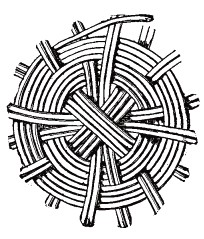 FIG. 15 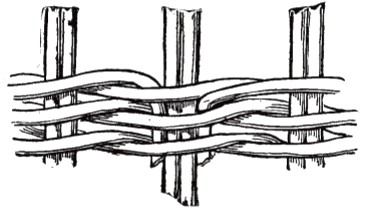 FIG. 16
Materials: BASKET-10 20-inch spokes of No. 4 rattan, 1 11-inch spoke of No. 4 rattan, 4 weavers of No. 2 rattan, Flat green rush. COVER AND KNOB.- 8 20-inch spokes of No. 4 rattan, 1 11-inch spoke of No. 4 rattan, 16 10-inch spokes of No. 4 rattan, 4 1/2 weavers of No. 2 rattan, Flat green rush, A knitting needle. In weaving with rush or raffia, but especially with rush, it is impossible to give the number of pieces necessary to make a basket, because of the varying length and thickness of the material. A caution will not be out of place in regard to soaking the rush. It should be wet just long enough to prevent its breaking when woven. As it is a very porous material it absorbs so much moisture if left too long in water that it shrinks badly when dry, and a basket that was quite firm when woven may become loose and shaky after the rush is dry. It follows of course that rush baskets should be very tightly woven, each weaver pressed down on those already in place, and sometimes, after the sides are finished, the weaving is bound down with string or linen thread (passed between the spokes and across the basket) and left to get perfectly dry before the border is made. In beginning this basket two groups of spokes, one of five and one of five and a half, are crossed in the centre. A weaver of green rush is bound around them and woven in under-and-over weaving into a bottom six and three-quarters inches in diameter which is slightly raised in the centre. The spokes are then wet until quite pliable, and turned sharply upward, with three rows of triple twist, to begin the straight sides of the basket. Next an inch and a quarter of rush is woven in under-and-over weaving, and five-eighths of an inch of triple twist forms a firm band at the top, which is completed with this border. Each Spoke in turn is brought in front of the spoke on the left and down inside the basket, where it is cut off after the border is finished. Cover. — The cover is woven of rush, on groups of four and four and a half spokes, until a centre four inches in diameter is made, when sixteen extra spokes are inserted, from the under side, one on the right of each Spoke but one. The ends of these spokes are held in place by a row of pairing in rush, the spokes being separated as it is woven around. The under-and-over weaving with rush then continues until the cover is seven and three-quarters inches in diameter. The spokes should next be thoroughly wet and turned sharply up, to make the straight sides, which are woven in triple twist for an inch and a quarter. In ending the last row of triple twist the following process will be found more satisfactory than the usual one. When the weaving reaches the point on the circumference of the basket where it began, each of the three ends is cut about an inch and a quarter beyond the last spoke behind which it was brought. Each end is then pressed down on the left of the next spoke and between the weaving. The border is a simple one. Each spoke is brought back of the next spoke on the left and out, where it is cut slanting just long enough to allow it to lie across the succeeding spoke. Knob. — A curious little button or knob, by which to lift the cover, is copied from one on a Chinese basket, and is made of a piece of No. 2 rattan, about half a length. The rattan is soaked until very pliable and then bent into a loop, like the one on the right of Fig. 17, leaving an end about four inches long. This loop should be a little over an inch across the widest part. The long end of the rattan is bent into another loop of the same size, the end being brought under the short end and up again, see Fig. 17; passing over the left side of the second loop, under the left side of the first loop, over the right side of the second loop, under the right side of the first loop and around to the right or inside of the short end, see Fig. 18. Here having made one circuit it follows the first circuit exactly, close to it and always on the inside. When the weaver has gone around four times it will have formed a little button or knob, with a small opening at the top and a larger one underneath; especially if the worker keeps this form in mind as he molds the rattan. The knob is attached to the centre of the cover by its two ends.
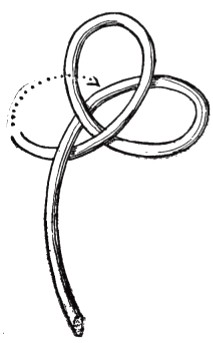
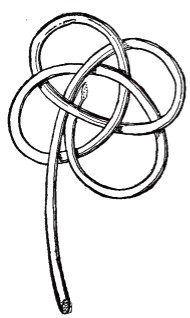 FIG. 17 FIG. 18
Material: 1 length of No. 4 rattan. A length of heavier rattan may be made into a simple and most useful napkin ring, for summer cottages or camps, by following the directions for the Chinese knob with but one difference. In making the second circuit, the beginning of which is shown in Fig. 18, the long end is brought on the left or outside of the short end and continues around on that side. Five circuits may be made instead of four if the ring does not seem firm enough at the end of the fourth. The ring form must of course be in mind all the time, so that it shall be molded into that instead of the knob shape. It may be finished in the natural color or stained (see Chapter XII). 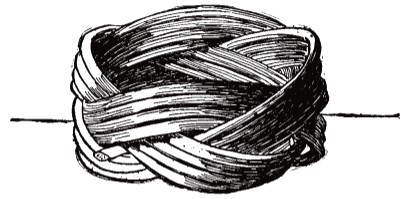 FIG. 19. — Napkin Ring
Materials: 16 32-inch pieces of No. 2 rattan, 10 weavers of No. 2 rattan, A knitting needle.
Here is something to make for the friend who knits or crochets; a little round basket that will hold her ball and needles and the piece of work too, if it is not very large. The sixteen pieces of No. 2 rattan are separated into groups of four each, which are crossed in the Indian way already described on page 67. Three rows of pairing are woven in No. 2 rattan, and then the groups are separated into twos, and the pairing continues while the basket is shaped as nearly round as possible. That there may be no ends of weavers inside the basket, to catch on the work, the method of joining weavers described on page 72 is used. At the widest point, when half of the fifth weaver has been woven in, the circumference should be about sixteen and three-quarters inches; from there it is gradually drawn in until, when the ninth weaver has been used, the diameter of the top is about four and a half inches. Each group of spokes is then brought over the next two groups on the right, back of the third group and outside. When this row is finished each group is brought down to the bottom of the basket on the outside, to a point an inch and a quarter from the centre and just in front of the next spoke to the one it last went behind, where it is drawn through two rows of weaving to hold it in place. These outside groups should be left quite loose as will be seen in the picture. When this process is finished (and a knitting needle will be a great help in accomplishing it) the basket is turned upside down and two rows of pairing are made to form part of a base; the end of each group is then brought over the next end to the right and pressed down inside (where they are afterward cut short), completing the base. |